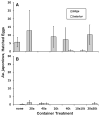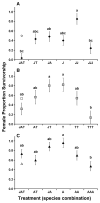Contributions of temporal segregation, oviposition choice, and non-additive effects of competitors to invasion success of Aedes japonicus (Diptera: Culicidae) in North America
- PMID: 26101466
- PMCID: PMC4474485
- DOI: 10.1007/s10530-014-0824-9
Contributions of temporal segregation, oviposition choice, and non-additive effects of competitors to invasion success of Aedes japonicus (Diptera: Culicidae) in North America
Abstract
The mosquito Aedes japonicus (Diptera: Culicidae) has spread rapidly through North America since its introduction in the 1990s. The mechanisms underlying its establishment in container communities occupied by competitors Aedes triseriatus and Aedes albopictus are unclear. Possibilities include (A) temporal separation of A. japonicus from other Aedes, (B) oviposition avoidance by A. japonicus of sites containing heterospecific Aedes larvae, and (C) non-additive competitive effects in assemblages of multiple Aedes. Containers sampled throughout the summer in an oak-hickory forest near Eureka, MO showed peak abundance for A. japonicus occurring significantly earlier in the season than either of the other Aedes species. Despite this, A. japonicus co-occurred with one other Aedes species in 53 % of samples when present, and co-occurred with both other Aedes in 18 % of samples. In a field oviposition experiment, A. japonicus laid significantly more eggs in forest edge containers than in forest interior containers, but did not avoid containers with low or high densities of larvae of A. triseriatus, A. albopictus, or both, compared to containers without larvae. Interspecific competitive effects (measured as decrease in the index of performance, λ') of A. triseriatus or A. albopictus alone on A. japonicus larvae were not evident at the densities used, but the effect of both Aedes combined was significantly negative and super-additive of effects of individual interspecific competitors. Thus, neither oviposition avoidance of competitors nor non-additive competitive effects contribute to the invasion success of A. japonicus in North America. Distinct seasonal phenology may reduce competitive interactions with resident Aedes.
Keywords: Container community; Multispecies competition; Oviposition behavior; Seasonal phenology.
Figures





Similar articles
-
Aedes albopictus (Diptera: Culicidae) Has Not Become the Dominant Species in Artificial Container Habitats in a Temperate Forest More Than a Decade After Establishment.J Med Entomol. 2021 Mar 12;58(2):950-955. doi: 10.1093/jme/tjaa215. J Med Entomol. 2021. PMID: 33073848 Free PMC article.
-
Effects of Competition and Predation by Native Mosquitoes on the North American Invasion of Aedes japonicus japonicus (Diptera: Culicidae).J Med Entomol. 2014 Nov 1;51(6):1159-67. doi: 10.1603/ME13179. J Med Entomol. 2014. PMID: 26309302
-
Community ecology of container mosquitoes (Diptera: Culicidae) in Virginia following invasion by Aedes japonicus.J Med Entomol. 2012 Nov;49(6):1318-27. doi: 10.1603/me11261. J Med Entomol. 2012. PMID: 23270159 Free PMC article.
-
The Importance of Interspecific Interactions on the Present Range of the Invasive Mosquito Aedes albopictus (Diptera: Culicidae) and Persistence of Resident Container Species in the United States.J Med Entomol. 2016 Sep;53(5):992-1001. doi: 10.1093/jme/tjw095. Epub 2016 Jun 28. J Med Entomol. 2016. PMID: 27354436 Review.
-
Invasion biology of Aedes japonicus japonicus (Diptera: Culicidae).Annu Rev Entomol. 2014;59:31-49. doi: 10.1146/annurev-ento-011613-162012. Annu Rev Entomol. 2014. PMID: 24397520 Free PMC article. Review.
Cited by
-
Diapause characterisation and seasonality of Aedes japonicus japonicus (Diptera, Culicidae) in the northeast of France.Parasite. 2021;28:45. doi: 10.1051/parasite/2021045. Epub 2021 May 26. Parasite. 2021. PMID: 34037519 Free PMC article.
-
Thermal experiments with the Asian bush mosquito (Aedes japonicus japonicus) (Diptera: Culicidae) and implications for its distribution in Germany.Parasit Vectors. 2018 Feb 5;11(1):81. doi: 10.1186/s13071-018-2659-1. Parasit Vectors. 2018. PMID: 29402295 Free PMC article.
-
Oviposition of Aedes japonicus japonicus (Diptera: Culicidae) and associated native species in relation to season, temperature and land use in western Germany.Parasit Vectors. 2020 Dec 17;13(1):623. doi: 10.1186/s13071-020-04461-z. Parasit Vectors. 2020. PMID: 33334377 Free PMC article.
-
Competition among Aedes aegypti larvae.PLoS One. 2018 Nov 15;13(11):e0202455. doi: 10.1371/journal.pone.0202455. eCollection 2018. PLoS One. 2018. PMID: 30439951 Free PMC article.
-
First Nationwide Monitoring Program for the Detection of Potentially Invasive Mosquito Species in Austria.Insects. 2022 Mar 10;13(3):276. doi: 10.3390/insects13030276. Insects. 2022. PMID: 35323574 Free PMC article.
References
-
- Allan SA, Kline DL. Larval rearing water and preexisting eggs influence oviposition by Aedes aegypti and Ae. albopictus (Diptera: Culicidae) J Med Entomol. 1998;35:943–947. - PubMed
-
- Alto BW. Interspecific larval competition between invasive Aedes japonicus and native Aedes triseriatus (Diptera: Culicidae) and adult longevity. J Med Entomol. 2011;48:232–242. - PubMed
-
- Andreadis TG, Wolfe RJ. Evidence for reduction of native mosquitoes with increased expansion of invasive Ochlerotatus japonicus japonicus (Diptera: Culicidae) in the northeastern United States. J Med Entomol. 2010;47:43–52. - PubMed
-
- Andreadis TG, Anderson JF, Munstermann LE, Wolfe RJ, Florin DA. Discovery, distribution, and abundance of the newly introduced mosquito Ochlerotatus japonicus (Diptera: Culicidae) in Connecticut, USA. J Med Entomol. 2001;38:774–779. - PubMed
Grants and funding
LinkOut - more resources
Full Text Sources
Other Literature Sources
